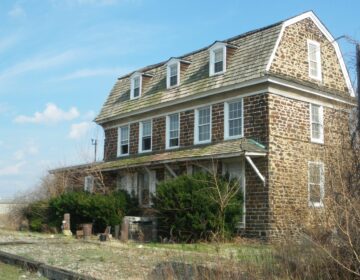Writers Block and Quark Park return in Princeton
The aroma of baking dough is wafting out the door of Witherspoon Bread Company. Illia Barger, about 20 feet up on a scissor lift, is applying paint to the bakery wall.
This is part of a series from Ilene Dube of The Artful Blogger.
The aroma of baking dough is wafting out the door of Witherspoon Bread Company. Illia Barger, about 20 feet up on a scissor lift, is applying paint to the bakery wall. Wearing paint-splattered coveralls and the signature headband that holds back her blond hair, the Arts Council of Princeton artist-in-residence is in week two of painting “Continuum,” a mural that relives the memories of Princeton’s beloved public garden projects: The Herban Garden, Writers Block and Quark Park.
Those were the days — and they were not so long ago. Begun in the early 2000s, all three projects had behind them “garden artist” Peter Soderman as visionary guru, restaurateurs Carlo and Raoul Momo, who allowed their space to be used and supported the projects (they own Witherspoon Bread, where Barger is painting today) and architect Kevin Wilkes. Now running for mayor of the consolidated Princeton Borough and Township, Wilkes credits the community collaboration on Writers Block as impetus for his political aspirations.
Behind a wooden door with a quirky window grille made from twisted twigs, the Herban Garden, begun in 2000, was a space to grow produce for the Momos’ restaurants, but was also the site of public art projects, farmers markets and performance pieces. Writers Block, 2004, assembled 12 Princeton architects to create follies for 12 Princeton writers, among them Paul Muldoon, Fran Liebowitz, James McPherson, Peter Benchley and Joyce Carol Oates. Quark Park did the same two years later with sculptors creating homages to scientists.
All of the parks were temporary — the land that Writers Block and Quark Park were on has been developed into townhouses — but their magic lives on in those who remember them — and now in Barger’s mural.
“Murals are fantastic for the community,” says Barger. “People walk by every day and feel like part of the process. And murals have a legacy of being great vehicles for making a statement. Why else would Rockefeller Center have sledge-hammered Diego Rivera’s mural?”
A good muralist also has to have the personality to respond to the many passersby — and Barger does. A driver pulls up under the mural and asks “can I leave my car here? I’ll leave my mother in it.”
“Is she good collateral?” retorts Barger. “You all right with that, Mom?”
Across the street, and not far from the site of the public gardens, is the Arts Council, where director Jeff Nathanson and Community Arts Manager Maria Evans had reminisced about the gardens, wondering what the Arts Council might do to bring them back.
One weekend, on a visit to Frenchtown, Evans ran into Barger, who runs an upcycled clothing business, Pantaluna. Evans asked if Barger, 50, knew of a muralist, not knowing that Barger herself was an accomplished painter of public art projects. Trained at Cooper Union, Barger’s first mural was at the Brooklyn Army Terminal, where she painted an underwater scene for a publicly funded childcare program.
There were many private murals that followed, and in 2005 Barger received a Dodge Foundation grant to create a mural on Warren Street in Trenton, depicting the first reading of the Declaration of Independence. Using trompe l’oeil, Barger created a large brick arch through which we see the 1776 reading. Outside the arch are symbols of the “Trenton Makes, the World Takes” era — pottery, rubber, cigars and steel. On the periphery, Barger painted some of the people who were around at the time she was painting.
Sadly, that mural was vandalized before it was completed, and so Barger learned to put a protective coat over her murals that can be washed off. Upon completing the mural, she painted the vandal behind bars.
Other murals include one in the new Capital Healthcare Systems in Hopewell and in Hamilton’s Grill in Lambertville.
Illia grew up in Carversville, Pa. Her family converted an old stone gristmill to their home and an antiques store. Her father was sculptor Raymond Barger, whose “Transition” stands at the entrance to the James A. Michener Art Museum in Doylestown. Her mother, Lilias Barger, was a composer, pianist and painter who opened a bakery and tea room to help support the family. Craig Claiborne came to review it, and Barger’s mother became famous for her pies.
Barger runs Pantaluna because “lowering the carbon footprint of each individual consumer” is important. “We are using what is considered a waste product — discarded T-shirts — to create a sustainable alternative. The clothing is unique and comfortable, and gives each wearer a sense of stewardship of the planet.”
For “Continuum,” she says she is more interested in the energy than the narrative. She interviewed people who remember the parks. Her vision is of “a cosmos with a flipped up perspective — like a child lying in the field, looking up.”
Glass bubbles float across the sky, like the glass bubbles from Quark Park, but they are filled with memories of Writers Block — the sunflowers and barn doors — and Herban Garden — a sculpture of a hand with plant life growing out of it by Robert Cannon.
Not only is Barger’s mural commemorating Princeton’s public gardens, but so is an exhibit at the Arts Council. Transient Spaces: Herban Garden, Writers Block, Quark Park, consisting of photographs, models and renderings, is on view at the Paul Robeson Center for the Arts through June 9. The exhibit opens tonight, May 3, 5 to 8 p.m., with a screening of Chris Allen’s film Quark Park at 7:30. The filmmaker and garden designers will be guest speakers.
To view a video of the project, visit Terra Momo Bread Company on Facebook.
The Artful Blogger is written by Ilene Dube and offers a look inside the art world of the greater Princeton area. Ilene Dube is an award-winning arts writer and editor, as well as an artist, curator and activist for the arts.
WHYY is your source for fact-based, in-depth journalism and information. As a nonprofit organization, we rely on financial support from readers like you. Please give today.




